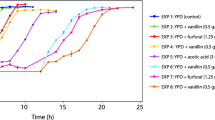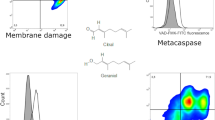Abstract
This work analyzed the pulsed light (PL) (0.0–71.6 J/cm2)-induced damage on Saccharomyces cerevisiae KE162 cells in peptone water (pH 3.5 or 5.6) and apple juice (pH 3.5) by applying flow cytometry (FCM) and transmission electronic microscopy. Cells were labeled with fluorescein diacetate (FDA) for detecting membrane integrity and esterase activity and with propidium iodide (PI) for monitoring membrane integrity. S. cerevisiae inactivation curves reached 6–7 log reductions (peptone water systems) and 3.9 log reductions (apple juice) after 60 s (71.6 J/cm2) of PL exposure. FCM revealed the same damage pattern (although at different doses) in all media: at low doses, there was an increase in population in PI+−FDA+ quadrant, while at high doses, most of the population was located at quadrant PI+–FDA−, indicating that PL provoked rupture of the cytoplasm membrane allowing PI to penetrate cells and there was progressive loss of esterase activity. Comparison of conventional culture technique with FCM revealed the occurrence of certain cell subpopulations in peptone water with pH 3.5 which were stressed and lost their ability to grow in agar but still showed metabolic activity. Transmission electron microphotographs of PL-treated cells clearly indicated that various cell structures other than plasma membranes were altered and/or destroyed in a different degree depending on exposure time and type of medium.





Similar content being viewed by others
References
Ananta, E., Heinz, V., & Knorr, D. (2004). Assessment of high pressure induced damage on Lactobacillus rhamnosus GG by flow cytometry. Food Microbiology, 21, 567–577.
Ananta, E., & Knorr, D. (2009). Comparison of inactivation pathways of thermal or high pressure inactivated Lactobacillus rhamnosus ATCC 53103 by flow cytometry analysis. Food Microbiology, 26, 542–546.
Aronsson, K., Rönner, U., & Borch, E. (2005). Inactivation of Escherichia coli, Listeria innocua and Saccharomyces cerevisiae in relation to membrane permeabilization and subsequent leakage of intracellular compounds due to pulsed electric field processing. International Journal of Food Microbiology, 99, 19–32.
Bolondi, A., Gaggino, O., & Monesiglio, J. (1995). Microscopía electrónica. Técnicas generales, C.I.C.V., INTA, Secretaría de Agricultura, Ganadería y Pesca from República Argentina Editorial.
Bunthof, C., Braak, S., Breeuwer, P., Rombouts, F., & Abee, T. (2000). Fluorescence assessment of Lactococcus lactis viability. International Journal of Food Microbiology, 55, 291–294.
Butz, P., & Tauscher, B. (2002). Emerging technologies: chemical aspects. Food Research International, 35, 279–284.
Choi, M., Cheigh, C., Jeong, E., Shin, J., & Chung, M. (2010). Nonthermal sterilization of Listeria monocytogenes in infant foods by intense pulsed-light treatment. Journal of Food Engineering, 97, 504–509.
Comas-Riu, J., & Rius, N. (2009). Flow cytometry applications in the food industry. Journal of Industrial Microbiology and Biotechnology, 36, 999–1011.
Register, F. (1999). Pulsed light treatment of food. Federal Register, 66, 338829–338830.
Ferrario, M., Guerrero, S., & Alzamora, S. M. (2012). High intensity light pulses (LP) inactivation of Saccharomyces cerevisiae in apple and melon juices: assessment of the physiological status by flow cytometry. Las Vegas, Nevada, USA: Presented at Institute of Food Technologists Annual Meeting and Food Expo. Presentation No 137–07. June 25–29.
Fleet, G. (1992). Spoilage Yeasts. Critical Reviews in Biotechnology, 112, 1–44.
Gómez, P., Salvatori, D., García-Loredo, A., & Alzamora, S. (2012). Pulsed light treatment of cut apple: dose effect on color, structure, and microbiological stability. Food and Bioprocess Technology, 5, 2311–2322.
Gómez-López, V., Ragaert, P., Debevere, J., & Devlieghere, F. (2007). Pulsed light for food decontamination: a review. Trends in Food Science and Technology, 18, 464–473.
Hewitt, C., & Nebe-Von Caron, G. (2001). An industrial application of multiparameter flow cytometry: assessment of cell physiological state and its application to the study of microbial fermentations. Cytometry, 44, 179–187.
Jun, S., Irudayaraj, J., Demirci, A., & Geiser, D. (2003). Pulsed UV-light treatment of corn meal for inactivation of Aspergillus niger spores. International Journal of Food Science and Technology, 38, 883–888.
Krishnamurthy, K., Demirci, A., & Irudayaraj, J. (2008a). Inactivation of Staphylococcus aureus in milk using flow-through pulsed UV-light treatment system. Food Microbiology and Safety, 72, 233–239.
Krishnamurthy, K., Tewari, J., Irudayaraj, J., & Demirci, A. (2008b). Microscopic and spectroscopic evaluation of inactivation of Staphylococcus aureus by pulsed light and infrared heating. Food and Bioprocess Technology, 3, 93–104.
Nebe von Caron, G., Stephens, P., Hewitt, C., Powell, J., & Badley, R. (2000). Analysis of bacterial function by multi-colour fluorescence flow cytometry and single cell sorting. Journal of Microbiological Methods, 42, 97–114.
Paparella, A., Taccogna, L., Aguzzi, I., Chaves-López, C., Serio, A., Marsilio, F., et al. (2008). Flow cytometric assessment of the antimicrobial activity of essential oils against. Listeria monocytogenes Food Control, 19, 1174–1182.
Pataro, G., Muñoz, A., Palgan, I., Noci, F., Ferrari, G., & Lyng, J. G. (2011). Bacterial inactivation in fruit juices using a continuous flow pulsed light (PL) system. Food Research International, 44, 1642–1648.
Rajkovic, A., Uyttendaele, M., Van Houteghem, N., & Osés Gómez, S. (2008). Influence of partial inactivation on growth of Listeria monocytogenes under suboptimal conditions of increased NaCl concentration or increased acidity. Innovative Food Science & Emerging Technologies, 10, 267–271.
Sauer, A., & Moraru, C. (2009). Inactivation of Escherichia coli ATCC 25922 and Escherichia coli O157:H7 in apple juice and apple cider using pulsed light treatment. Journal of Food Protection, 72, 937–944.
Schenk, M., Raffellini, S., Guerrero, S., Blanco, G., & Alzamora, S. (2011). Inactivation of Escherichia coli, Listeria innocua and Saccharomyces cerevisiae by UV-C light: study of cell injury by flow cytometry. Lebensmittel-Wissenschaft Und-Technologie-Food Science and Technology, 44, 191–198.
Takeshita, K., Shibato, J., Sameshima, T., Fukunaga, S., Isobe, S., & Itoh, M. (2003). Damage of yeast cells induced by pulsed UV light irradiation. International Journal of Food Microbiology, 85, 151–158.
Ueckert, J., Breeuwer, P., Abee, T., Stephens, P., Nebe von Caron, G., & Steeg, P. (1995). Flow cytometry applications in physiological study and detection of foodborne microorganisms. International Journal of Food Microbiology, 28, 317–326.
Van Houteghem, N., Devlieghere, F., Rajkovic, A., Gomez, S. M. O., Uyttendaele, M., & Debevere, J. (2008). Effects of CO2 on the resuscitation of Listeria monocytogenes injured by various bactericidal treatments. International Journal of Food Microbiology, 123, 67–73.
Wambura, P., & Verghese, M. (2011). Effect of pulsed ultraviolet light on quality of sliced ham. Lebensmittel-Wissenschaft Und-Technologie-Food Science and Technology, 44, 2173–2179.
Wang, T., MacGregor, S., Anderson, J., & Woolsey, G. (2005). Pulsed ultraviolet inactivation spectrum of Escherichia coli. Water Research, 39, 2921–2925.
Wekhof, A. (2000). Disinfection with flash lamps. Journal of Pharmaceutical Science and Technology, 54, 264–276.
Woodling, S. E., & Moraru, C. I. (2005). Influence of surface topography on the effectiveness of pulsed light treatment for the inactivation of Listeria innocua on stainless-steel surfaces. Journal of Food Science, 70, 345–351.
Zhao, W., Yang, R., Zhang, H., Zhang, W., Hua, X., & Tang, Y. (2011). Quantitative and real time detection of pulsed electric field induced damage on Escherichia coli cells and sublethally injured microbial cells using flow cytometry in combination with fluorescent techniques. Food Control, 2, 566–573.
Acknowledgments
The authors would like to acknowledge the financial support from Universidad de Buenos Aires, CONICET, and ANPCyT of Argentina and from BID.
Author information
Authors and Affiliations
Corresponding author
Rights and permissions
About this article
Cite this article
Ferrario, M., Guerrero, S. & Alzamora, S.M. Study of Pulsed Light-Induced Damage on Saccharomyces cerevisiae in Apple Juice by Flow Cytometry and Transmission Electron Microscopy. Food Bioprocess Technol 7, 1001–1011 (2014). https://doi.org/10.1007/s11947-013-1121-9
Received:
Accepted:
Published:
Issue Date:
DOI: https://doi.org/10.1007/s11947-013-1121-9




